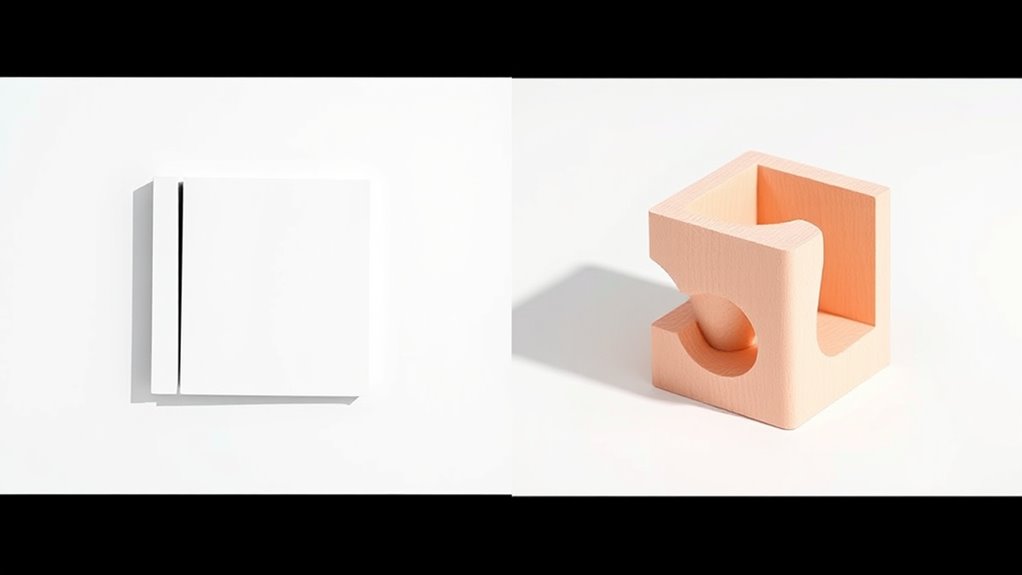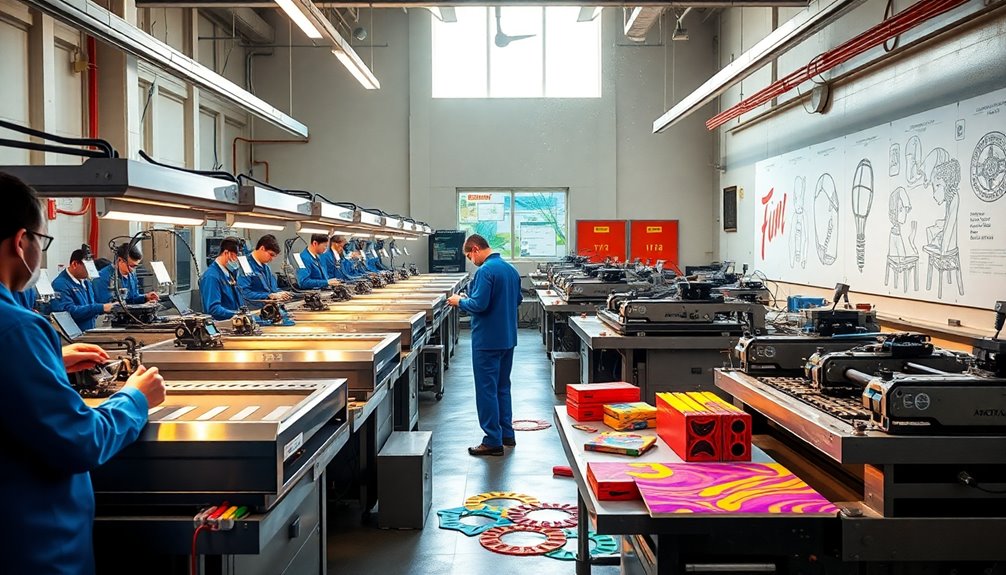When comparing 2D and 3D design principles, you’ll notice that 2D focuses on creating the illusion of depth using techniques like shading, perspective, and visual hierarchy on flat surfaces. In contrast, 3D emphasizes understanding volume, realistic lighting, and spatial relationships to produce tangible, immersive models. Your approach depends on whether you want quick visual communication or a more lifelike, interactive experience. Keep exploring to uncover how mastering these principles can elevate your designs further.
Key Takeaways
- 2D design emphasizes visual cues like shading, perspective, and overlapping to create an illusion of depth on flat surfaces.
- 3D design focuses on understanding volume, form, and realistic lighting to produce tangible, immersive objects.
- 2D principles rely on balance, contrast, and alignment to guide visual hierarchy without physical spatiality.
- 3D principles involve spatial relationships, multi-angle viewing, and accurate light and shadow for realism.
- Both require mastery of different tools tailored to flat visuals (2D) or volumetric, interactive models (3D).

When choosing between 2D and 3D design, understanding their core principles is essential for making informed decisions. Both approaches serve different purposes and require distinct skills, especially when it comes to creating visual depth and spatial awareness. In 2D design, you’re working within flat planes, relying on techniques such as shading, perspective, and color contrast to suggest depth. Your goal is to simulate three-dimensionality on a two-dimensional surface, which demands a keen eye for how visual elements interact to create the illusion of space. You manipulate lines, shapes, and textures to guide the viewer’s eye and establish a sense of hierarchy and depth, even without actual spatial dimensions.
Understanding core principles guides effective use of 2D and 3D design techniques.
In contrast, 3D design immerses you into a domain where spatial awareness becomes tangible. You’re constructing objects with actual volume, depth, and physicality, allowing for a more realistic and immersive experience. When working in 3D, you’re not just simulating space—you’re creating it. Your focus shifts to understanding how different elements occupy physical space, how they relate to one another, and how light interacts with surfaces. This spatial awareness is vital because it influences how your design can be navigated or interacted with, whether in virtual environments, animations, or physical models. You need to think in three dimensions, considering how objects look from multiple angles, how they move, and how they connect to their surroundings.
The core principles of each approach reflect these differences. In 2D design, principles like balance, contrast, and alignment help evoke a sense of depth and spatial relationships on a flat canvas. You might use techniques such as overlapping objects or varying shades to suggest that some elements are closer or farther away. Meanwhile, 3D design emphasizes principles like volume, form, and lighting, which are essential for creating realistic or stylized three-dimensional objects. Your understanding of how light and shadow fall on surfaces enhances the sense of realism and spatial depth.
Additionally, mastering the different tools used in 2D and 3D design is crucial for effectively applying these principles to your projects. Ultimately, your choice depends on what you want to achieve. If your aim is to communicate ideas quickly and efficiently on a flat surface, 2D design offers simplicity and clarity. But if you’re creating immersive experiences or realistic models, mastering 3D design provides the tools for true spatial expression. Both require a grasp of how visual depth and spatial awareness shape perception, but they do so through different methods and applications.
Frequently Asked Questions
How Do 2D and 3D Designs Impact User Experience?
You’ll find that 2D and 3D designs notably impact your user experience by influencing visual clarity and user engagement. 2D designs often offer simplicity, making information easy to understand and navigate, which boosts clarity. Meanwhile, 3D designs create immersive experiences, engaging your attention and increasing engagement. Both styles serve different purposes, and choosing the right one depends on your goals for clarity and how deeply you want users to connect with your content.
What Tools Are Best for Beginners in 3D Design?
You might think advanced software is necessary, but beginner tools like Tinkercad, SketchUp, and Blender make starting easy. These programs are user-friendly and offer tutorials, so you can learn quickly. Many artists and designers swear by them, proving that you don’t need complex software to create impressive 3D models. Start with these recommendations, practice regularly, and you’ll develop your skills faster than you imagined.
How Do Costs Compare Between 2D and 3D Projects?
You’ll find that 2D projects are generally more cost-efficient, making them ideal if you’re working with a tight budget. 3D projects tend to be more expensive due to the need for specialized software, hardware, and time-consuming modeling. When planning your project, consider your budget considerations carefully, as 3D design often requires higher investment but can offer more detailed, realistic results compared to 2D.
Can 2D Designs Be Easily Converted Into 3D Models?
You can usually convert 2D designs into 3D models, but the feasibility depends on the design’s complexity. Simple, clear 2D sketches make the conversion process smoother, while complex or detailed designs may require significant adjustments and additional work. You’ll need to take into account the design’s details and accuracy to guarantee a successful transition, but with the right tools and expertise, converting 2D to 3D is often achievable.
What Industries Primarily Use 3D Design Principles?
When it comes to industries, 3D design principles are where the magic happens. You’ll find them in architectural visualization, helping clients see future structures in detail, and in medical imaging, where 3D models reveal complex anatomy clearly. These industries rely on 3D to bring ideas to life and improve understanding. If you’re in these fields, mastering 3D design gives you a leg up—making your work more impactful and precise.
Conclusion
Ultimately, whether you choose 2D or 3D design, it’s amazing how these principles often overlap in unexpected ways. As you explore each, you might find yourself surprised by how 2D’s simplicity enhances 3D’s complexity, or vice versa. It’s like they’re two sides of the same coin, constantly influencing each other. So, keep experimenting—sometimes, the best design ideas come from the coincidence of both worlds coming together seamlessly.










